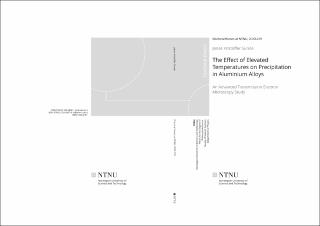| dc.contributor.advisor | Holmestad, Randi | |
| dc.contributor.advisor | Marioara, Calin Daniel | |
| dc.contributor.author | Sunde, Jonas Kristoffer | |
| dc.date.accessioned | 2020-09-16T12:23:27Z | |
| dc.date.available | 2020-09-16T12:23:27Z | |
| dc.date.issued | 2020 | |
| dc.identifier.isbn | 978-82-326-4807-8 | |
| dc.identifier.issn | 1503-8181 | |
| dc.identifier.uri | https://hdl.handle.net/11250/2678093 | |
| dc.description.abstract | Aluminium (Al) alloys are increasingly found and sought-after in applications that involve exposure to elevated temperatures. Examples are automotive components located in the engine room, heat exchangers, and subsea/offshore electrical cables. By using lighter Al substitutes for components made of steel in automotive applications (Al has about 1/3 the density of steel), the reductions in weight lead to large reductions in gas emissions or may extend the range of electrical vehicles significantly. However, it is important that this does not come at the cost of reduced crashworthiness or thermal stability of key components. If given sufficient amounts of time and temperature, the microstructure – and hence properties – of an Al alloy will change. Therefore, a fundamental understanding of the behaviour of Al alloys after prolonged exposure to elevated temperatures is needed, which has been a major part of the motivation for this work.
Al-Mg-Si(-Cu) alloys are frequently used in automotive components and obtain their strength primarily due to high densities of nanosized, rod-shaped precipitate phases that form during thermal treatments. The transmission electron microscope (TEM) is an excellent tool for studying these precipitates. By changing alloy compositions and thermomechanical processing routes, there are possibilities for large variations in the types of forming precipitate phases, their sizes, and their dispersion in the Al matrix, which has important consequences for material properties. This thesis presents several studies of microstructure-property relationships existing in these alloys as a function of thermal exposure, linking the distribution of precipitates to material properties such as mechanical yield strength and electrical conductivity.
Among the main findings, it is shown how scanning electron diffraction combined with advanced data analysis will become an important tool in future alloy design, by obtaining improved precipitate statistics from larger regions of the sample in a more objective manner than by using conventional approaches. Furthermore, it was found that low additions of Cu (0.01 atomic %), being a common alloying element in these alloys, may change the Al-Mg-Si system precipitation, particularly after long temperature exposure. This has important implications for alloy recycling, where inclusions of trace elements are practically unavoidable. In addition, direct observations of precipitate transformations during thermal ageing have been achieved using in situ heating TEM. In the study of an Al-Mg-Si-Cu alloy, it was shown that the fragmented L phase exhibits a significantly improved thermal stability as compared to the main age-hardening precipitate phase β’’. It is finally emphasised that the methodologies applied and developed in this work have potential for broad applications within multi-phase materials, such as other metallic systems, semiconductors, and minerals. | en_US |
| dc.language.iso | eng | en_US |
| dc.publisher | NTNU | en_US |
| dc.relation.ispartofseries | Doctoral theses at NTNU, 2020:229 | |
| dc.relation.haspart | Paper 1:
Sunde, Jonas Kristoffer; Paulsen, Øyvind; Wenner, Sigurd; Holmestad, Randi.
Precipitate statistics in an Al-Mg-Si-Cu alloy from scanning precession electron diffraction data. Journal of Physics: Conference Series 2017 ;Volum 902.(1)
https://doi.org/10.1088/1742-6596/902/1/012022
(CC BY 4.0) | |
| dc.relation.haspart | Paper 2:
Sunde, Jonas Kristoffer; Marioara, Calin Daniel; Van Helvoort, Antonius; Holmestad, Randi.
The evolution of precipitate crystal structures in an Al-Mg-Si(-Cu) alloy studied by a combined HAADF-STEM and SPED approach. Materials Characterization 2018 ;Volum 142. s. 458-469
https://doi.org/10.1016/j.matchar.2018.05.031 | |
| dc.relation.haspart | Paper 3:
Sunde, Jonas Kristoffer; Johnstone, D.N.; Wenner, Sigurd; Van Helvoort, Antonius; Midgley, Paul A.; Holmestad, Randi.
Crystallographic relationships of T-/S-phase aggregates in an Al–Cu–Mg–Ag alloy. Acta Materialia 2019 ;Volum 166. s. 587-596
https://doi.org/10.1016/j.actamat.2018.12.036 | |
| dc.relation.haspart | Paper 4:
Sunde, Jonas Kristoffer; Wenner, Sigurd; Holmestad, Randi.
In situ heating TEM observations of evolving nanoscale Al‐Mg‐Si‐Cu precipitates. Journal of Microscopy 2019 ;Volum 279.(3) s. 143-147
https://doi.org/10.1111/jmi.12845
This is an open access article under the terms of the Creative Commons Attribution‐NonCommercial‐NoDerivs License (CC BY-NC-ND 4.0) | |
| dc.relation.haspart | Paper 5:
Sunde, Jonas Kristoffer; Marioara, Calin Daniel; Holmestad, Randi.
The effect of low Cu additions on precipitate crystal structures in overaged Al-Mg-Si(-Cu) alloys. Materials Characterization 2020 ;Volum 160.
https://doi.org/10.1016/j.matchar.2019.110087
This is an open access article under the terms of the Creative Commons
Attribution 4.0 International (CC BY 4.0) | |
| dc.relation.haspart | Paper 6:
Sunde, Jonas Kristoffer; Lu, Feng; Marioara, Calin Daniel; Holmedal, Bjørn; Holmestad, Randi.
Linking mechanical properties to precipitate
microstructure in three high strength Al-Mg-Si(-Cu) alloys.
The final published version is available in
Materials Science and Engineering: A
Volume 807, 11 March 2021, 140862
https://doi.org/10.1016/j.msea.2021.140862
This is an open access article under the terms of the Creative Commons
Attribution 4.0 International (CC BY 4.0) | |
| dc.relation.haspart | Paper 7:
Sunde, Jonas Kristoffer; Marioara, Calin Daniel; Holmestad, Randi.
On the microstructural origins of improvements in
conductivity by heavy deformation and ageing of Al-Mg-Si
alloy 6101.
The final published version is available in Materials Characterization
https://doi.org/10.1016/j.matchar.2021.111073
This is an open access article under the terms of the Creative Commons
Attribution 4.0 International (CC BY 4.0) | |
| dc.title | The Effect of Elevated Temperatures on Precipitation in Aluminium Alloys – An Advanced Transmission Electron Microscopy Study | en_US |
| dc.type | Doctoral thesis | en_US |
| dc.subject.nsi | VDP::Mathematics and natural science: 400::Physics: 430 | en_US |
